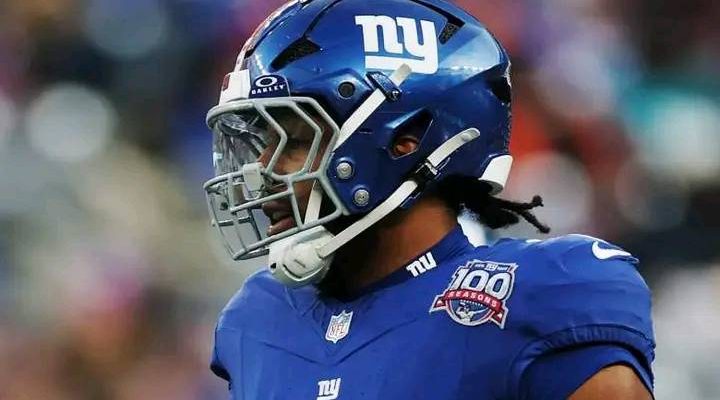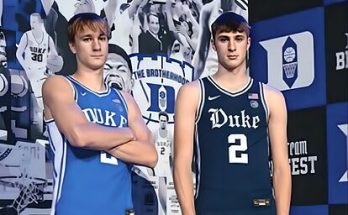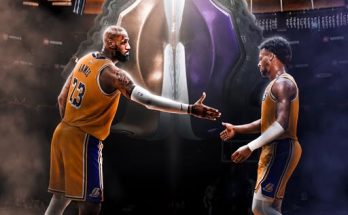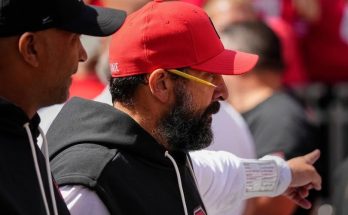The New York Giants are once again at a pivotal moment in their franchise’s storied history, and the clock is ticking loudly inside MetLife Stadium. The franchise, once the pride of smash-mouth defense and stable quarterback play, appears to be on the verge of a dramatic overhaul before the 2025 NFL season even kicks off. Reports have surfaced that the team is preparing to move on from one of its most expensive defensive players—a \$31 million star—well ahead of Week 1. This development comes amid a sweeping change on the offensive side of the ball, where a new quarterback-wide receiver duo is reportedly stealing the show and setting a new tone for the team’s identity.
This is no longer the era of Giants football defined solely by its defense. The shifting tide suggests a changing of the guard that could ripple through the entire NFC East. Long known for clinging tightly to its cornerstone defensive stars, the Giants are now doing what few expected: actively shopping or preparing to cut ties with a player who, until recently, was viewed as central to their defensive future. Financial considerations are a factor, but this move is just as much about vision, leadership, and scheme fit. The move signals a shift in priorities, and perhaps a lesson in the economics of modern-day football.
At the center of the drama is a player many believed would anchor the Giants’ defense for years to come. He’s battled through injuries, served as a veteran voice in the locker room, and often faced double teams while maintaining productivity. But now, whether due to age, cap hit, or the emergence of younger talent, his days with Big Blue may be numbered. While names aren’t officially confirmed, several insiders point to defensive lineman Leonard Williams as a likely candidate. Having once signed a lucrative three-year deal worth \$63 million with the team, the cap burden he brings has become increasingly difficult to justify.
The Giants’ defensive schemes have undergone several iterations over the last few seasons, from Patrick Graham’s flexible 3-4 sets to Wink Martindale’s aggressive blitz-heavy packages. That level of turnover puts pressure on veterans, especially high-paid ones, to remain adaptable. In Williams’ case, while his effort and leadership have rarely been questioned, the fit in evolving schemes has been far from seamless. The Giants’ front office, led by GM Joe Schoen, appears ready to cut their losses. The numbers simply do not add up: over \$30 million in cap liabilities for a player whose production, while steady, may not meet the returns required at that price tag.
There’s also a cultural and competitive dimension to this shift. The locker room is changing. The infusion of youth across both sides of the ball is undeniable. Draft picks and younger players on rookie contracts have outpaced veterans in terms of energy, explosiveness, and sometimes, raw productivity. Coaches want to reward hustle and discipline—not just seniority and past contracts. It becomes increasingly difficult to preach accountability when underperforming veterans stay on the roster because of guaranteed money, while younger players languish on the bench.
But this isn’t just about who the Giants might be losing. It’s also about who is rising. The Giants appear to be embracing a seismic change on offense. Training camp reports, offseason scrimmages, and insider buzz all point to the emergence of a new quarterback-wide receiver duo that could electrify the franchise and the fanbase alike. Rookie QB Jaxson Dart, a bold and aggressive signal-caller fresh out of Ole Miss, is turning heads not only with his arm talent but with his leadership presence. Pairing him with Malik Nabers, the first-round pick from LSU who brings a dynamic blend of speed, route-running, and confidence, might be the best thing the Giants have done since drafting Saquon Barkley.
In previous years, Giants fans were conditioned to manage expectations. Quarterback inconsistency, offensive line struggles, and a revolving door of receivers left much to be desired. But Dart has brought an edge to camp that has resonated with both teammates and coaches. He isn’t just a quarterback with a big arm—he’s a tone-setter, someone who doesn’t shy away from pressure and embraces the responsibility of leading an NFL franchise. His chemistry with Nabers has been instantaneous, the kind of connection that transcends playbook reps and turns into something instinctive on the field.
Together, Dart and Nabers have produced highlight after highlight during scrimmages, red zone drills, and full 11-on-11 sessions. Dart’s ability to extend plays, paired with Nabers’ innate feel for separation, has made the duo nearly unstoppable in practice. They’ve also displayed maturity beyond their years—studying film together late into the night, challenging each other to be better, and even organizing informal workouts with other offensive weapons to fine-tune timing. That level of synergy is not common for a rookie duo. The front office, coaching staff, and even defensive players have acknowledged their emerging dominance.
The Giants have made it clear that they are building a team that can compete now and later. But doing so means trimming the fat, no matter how emotionally or financially costly it might be. Shedding a \$31 million contract, especially one tied to a veteran defensive leader, is a calculated risk. It’s a message that production over pedigree will define this new era. And in a cap-sensitive league, every dollar saved from such a move can be reinvested into extending the contracts of young stars, beefing up the offensive line, or acquiring more talent via free agency.
There’s also the locker room morale to consider. Cutting or trading a longtime veteran can have ripple effects. But it can also free up leadership roles for emerging voices. If Dart continues to perform the way he has, there’s no doubt he’ll become the emotional engine of the team. Pair that with Nabers’ infectious confidence and the Giants might be looking at a cultural transformation just as impactful as any schematic change. The team has seen what it looks like to invest heavily in defense and watch the offense falter. Now, the pendulum is swinging toward offensive dynamism. In today’s NFL, where scoring matters more than ever and defenses are stretched thin by versatile weapons, this may be the pivot the Giants desperately needed.
That said, the risk cannot be ignored. If the defensive line underperforms after moving a veteran like Williams (or another highly-paid defender), fingers will point quickly. The NFL is brutal in that way. Coaches and GMs who miscalculate talent valuation can find themselves on the hot seat. And for a fanbase as passionate and history-rich as the Giants’, patience has never been limitless. But for now, the mood around the franchise is one of cautious optimism. Letting go of a \$31 million defender might be a difficult pill to swallow, but the payoff of investing fully in the new offense could be tremendous.
Additionally, there’s a very real competitive urgency. The NFC East is as stacked as ever. The Eagles, Cowboys, and even the rising Commanders have weapons on both sides of the ball. To compete, you need not only talent, but vision. The Giants appear to be building theirs around speed, youth, and adaptability. That’s not to say the defense will be an afterthought—it won’t. But the days of overpaying for “name” defenders who no longer fit the scheme may be over. The new model is one that prioritizes multipositional flexibility, athleticism, and cap efficiency. With rising stars on rookie deals, the Giants finally have a chance to get aggressive in the right way.
One quiet but important point is how this shift affects the coaching staff. Brian Daboll, who built his reputation developing Josh Allen in Buffalo, now has a canvas to paint with in Dart. He’s no longer coaching around limitations; he’s coaching with promise. That changes how you call a game, how you install packages, and how you structure an offense. With a wideout like Nabers who can take the top off a defense or carve up zones, Daboll has the luxury of being creative again. The Giants’ playbook is likely to expand significantly, and the days of boring, predictable drives may soon be behind them.
From a fan perspective, this changing of the guard will likely be met with mixed emotions. Some will lament the loss of a defensive mainstay, pointing to leadership and intangibles. Others will embrace the boldness of pivoting fully toward a new offensive future. But what cannot be denied is this: the Giants are moving with purpose. They’re no longer content with mediocrity or stuck in the middle. Shedding an expensive, aging contract and empowering a dynamic young QB-WR tandem is the kind of decisive move that could either spark a renaissance or become another footnote in the team’s rebuilding cycle.
The NFL has evolved into a league that rewards efficiency, versatility, and star power on offense. The Giants seem to be taking that to heart. The decision to part ways with a \$31 million defender won’t be easy. It never is when you’ve invested so heavily, both financially and emotionally, into a player. But football is a cold business at times, and the Giants’ leadership seems willing to make the tough calls necessary for long-term success.
The Giants are on the brink—of what, remains to be seen. But for the first time in a long time, the possibilities feel expansive rather than limited. The emergence of Jaxson Dart and Malik Nabers could be the rebirth of an offensive identity that the Giants have sorely lacked for over a decade. If they hit their ceiling, the Giants might soon shed the label of “defensive team with offensive issues” and instead become the kind of multidimensional threat that gives opposing coordinators sleepless nights.
So while one door may be closing—on a veteran defensive star who gave his all to the franchise—another one is wide open. Behind it stands a quarterback hungry to lead, a wide receiver ready to explode, and a team daring to believe in a future built on bold moves, not fear of change. As the 2025 season approaches, the Giants aren’t just making roster moves—they’re making a statement.



